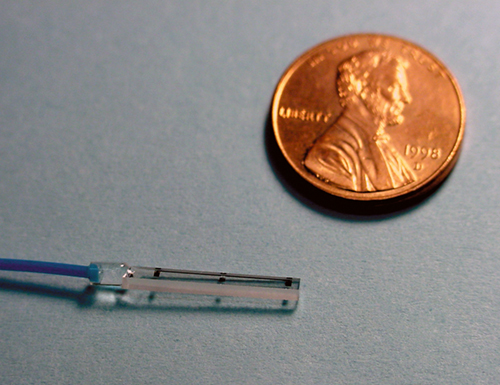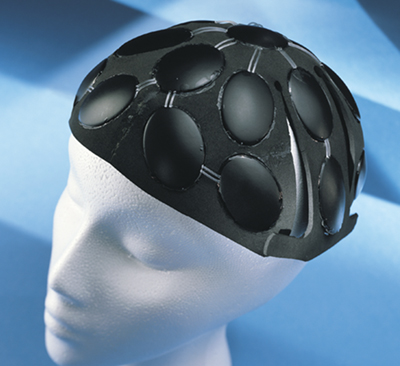Superior Sensor Making Sense in Military, Medicine
Originating Technology/ NASA Contribution
A fiber-optic voltage sensor developed a decade ago for NASA’s aircraft and space power systems has been the building block for a string of new sensor products offering safe, accurate detection and measurement for electrically noisy and hazardous environments.
Srico, Inc., a Columbus, Ohio-based photonics engineering company, created the original voltage sensor in cooperation with NASA’s Glenn Research Center under a Small Business Innovation Research (SBIR) contract, and successfully marketed it as a solution for fiber-optic communication systems, noncontact probing of high-speed integrated circuits, biomedical engineering and instrumentation, and lightning detection in avionics and mining. The technology has since been propelled to a higher level to address electrodiagnostics, patient monitoring, and functional magnetic resonance imaging (the ability to study the brain’s function, not just its structure, like traditional magnetic resonance imaging), as well as physiological monitoring of military pilots and combat personnel.
Partnership
In developing the follow-on optical sensing products, Srico was also awarded a generous grant from the Garrett Morgan Commercialization Initiative, established by Glenn Research Center to assist small, minority- and women-owned businesses in taking NASA-derived technology to market. This initiative is managed by the Great Lakes Industrial Technology Center (GLITeC).
“Our company is very honored and grateful to receive such a prestigious award,” says Dr. Sri Sriram, Srico’s chief executive officer. “This grant is very timely, because the worldwide demand for our optical components is very high, yet the supply is limited.”
Product Outcome
Srico’s small lithium niobate photonic electrode, or Photrode,™ represents a paradigm shift in technology for sensing electrophysiological signals, particularly electroencephalography (EEG) and electrocardiography (EKG) signals. While current methods for executing EEG and EKG measurements require the attachment of electrical wires to a patient’s scalp or chest, Srico’s Photrode invention manipulates light to measure the electrophysiological signals produced by the body, otherwise known as biopotentials. Unlike conventional electrodes, Photrode measurements do not require skin preparation or the use of adhesives or conductive gels. This makes the technology ideal for dry-contact sensing of low-level EEG signals and noncontact sensing of high-level EKG signals (EKG readings can be taken directly over clothing with the Photrode).
The basic Photrode system consists of a laser source, optical input and output fibers, an optical chip, an optical receiver, and signal-processing components. When a Photrode sensor picks up a biopotential signal, light from a continuous wave laser source enters the sensor and becomes modulated by the signal. The optical receiver then detects and digitizes the voltage output of the Photrode.
With NASA technology at its core, the Photrode was developed for the U.S. Army Aeromedical Research Laboratory to assess the physiological- and flight-readiness of Army pilots, and for the Walter Reed Army Institute of Research’s departments of neuropsychiatry and surgery, for ambulatory alertness-monitoring and triage applications, respectively. Ongoing research and development was extended to the U.S. Army, enabling it to monitor in real time the alertness levels of its personnel and to assess their cognitive performance and sleep/wake status in sustained operational settings. Previously, the Walter Reed Army Institute of Research demonstrated that soldiers who have been awake for 48 to 72 hours rapidly lose their ability to make correct judgments. This lack of sleep has been suggested as a possible cause of friendly fire casualties and loss of expensive equipment. Other studies have supported this notion, further indicating that both sleep (low-frequency EEG) and alertness (high-frequency EEG) measurements are critical in determining a soldier’s level of performance and in avoiding incidents that are due to a decline in cognitive function.
With the Photrode, it is now possible to integrate the low-frequency domain of sleep with the high-frequency domain of active brain-functioning into one compact, pocketsize ambulatory system. Photrode introduces the potential to acquire the full range of EEG signals, thereby facilitating the possibility of creating an alertness/drowsiness index for evaluating performance capability in both military and civilian operational settings—where awareness is vital.
Subsequent research and development efforts made possible by grants from the National Institutes of Health demonstrated that Srico’s Photrode sensor is viable for magnetic resonance imaging. According to Sriram, it is currently not possible to safely monitor a patient’s brain activity when a magnetic resonance scanner is turned on, because the traditional electrical leads used to monitor the EEG interfere with the high radio frequency fields in the magnetic resonance environment. “This not only can distort the images, but it can also cause severe burns to a patient,” he adds. By enabling uninterrupted capture of all of the brain’s activity, the Photrode system combines the high temporal resolution of the EEG signals with the exquisite spatial resolution of magnetic resonance images. There is no interference with the radio frequency and magnetic fields of the scanner, and there is no risk of thermal or electrical burns.
The sensor technology, a recipient of Rx Magazine’s esteemed Rx 100 Award, could be used for any type of electrophysiological measurement in airline pilots, unmanned aerial vehicle control station operations, heavy machinery operators, nuclear power plant employees, truck drivers, and many other occupations that demand high levels of alertness and performance over a long duration.
Srico also markets NASA-influenced wideband integrated optic modulators and fiber-optic microwave links for voltage testing/measurement and signal transmission in industrial fields. These low-drive voltage, high-damage threshold products are well-suited for cable television systems; antenna remoting; automotive and medical electronics testing; aircraft testing; and wireless, satellite, and fiber-optic communications.
Photrode™ is a trademark of Srico, Inc.

The Photrode™ all-optical sensor manipulates light to measure the electrophysiological signals produced by the body (penny shown for scale).

Photrode™ sensors, shown here mounted on a helmet, use Srico, Inc.’s proprietary technology for improved, hassle-free, noncontact electrocardiography and dry-contact electroencephalography measurement.













